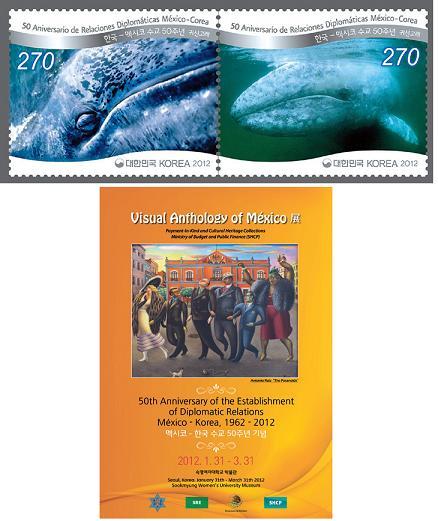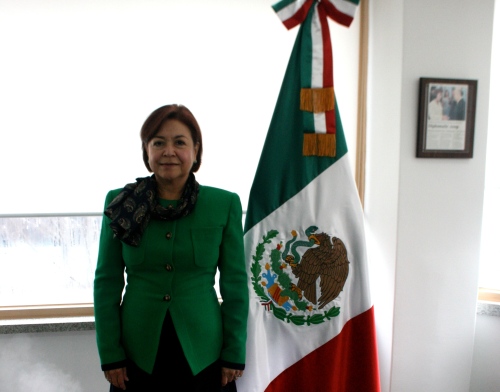
(top)Stamps issued to celebrate Mexico’s 50th year of diplomatic ties with Korea.(down)“Visual Anthology of Mexico” poster
Some of Mexico’s greatest artists of the 20th century are to have their work displayed in Korea for the first time.
The works of internationally renowned painters such as Diego Rivera and Rufino Tamayo are being displayed in Seoul as part of a new exhibition to showcase the works of 47 Mexican artists.
The Central American country is bringing the collection representing some of its most renowned modern artists to Korea for the “Visual Anthology of Mexico” at Sookmyung Women’s University Museum.
The exhibition’s 35 paintings as well as sculptures, photos, video instillations and object art promises to show Korean visitors the development of the Mexican arts during the last century.
The collection is being brought by the Mexican foreign affairs ministry and the embassy here to celebrate 50 years of diplomatic ties between the two countries.
A commemorative stamp bearing the image of the great whale, which is protected at Mexican sanctuaries, was also launched in Korea on Jan. 26 to mark the diplomatic anniversary.
The exhibition will be opened on Jan. 31 by Mexican ambassador Martha Ortiz de Rosas and Sookmyung Women’s University president Han Young-Sil. It will run until March 31.
“We will have the opportunity to exhibit the works of 47 Mexican artists who are universally renowned. Mainly painters, some sculpture and visual arts,” Ortiz de Rosas said.

Mexican ambassador Martha Oritz de Rosas stands next to her national flag at her embassy. (Kirsty Taylor/The Korea Herald)
“They are part of the very important movement in Mexico ― the pictoric schools of the 20th century ― which started in the early 1910s after the revolution, up to date.
“This was a very rich time in art in Mexico and all these artists have influenced the universal art, which is also very important. Part of these works are very Mexican but others are very universal.
“Some are part of the nationalistic and socialist movement, but we will present other artists’ abstract works.”
Mexican plastic arts were an important means of supporting the development of the country in the 20th century, after a century of social struggles. These years after the country’s revolution were an era of important cultural movements including the Open-Air Painting Schools and the Mexican School of Painting, the Rupture Generation and Neomexicanism.
At the Korean exhibition, Rufino Tamayo’s lithograph “Iron Cross” (1999) will represent his works as a product of the Open-Air Painting Schools that operated between 1913 and the 1930s to leave behind traditionalist academic styles.
Diego Rivera’s painting “Urban landscape or collecting snow” (1956) will also be displayed. Rivera is a renowned product of the nationalistic Mexican School of Painting from the 1920s-1950s, which included the Muralist Movement democratized art through displays on public building walls.
Many painters of the Rupture Generation, including Manuel Felguerez, Jose Luis Cuevas, Gunther Gerzo and others, will also have works shown in the Korean exhibition. These were artists who started to react against nationalistic ideals in Mexico to incorporate more cosmopolitan, abstract and non-political values in their work during the 1950s.
“They are artists that are very well known worldwide and it is the first time that we will present this exhibition owned by our ministry of budget and finance in Mexico,” Ortiz de Rosas said. “It is lent to us and sent by the ministry of foreign affairs in a great effort because we consider the partnership with Korea as very important. We would like to transmit this to the Korean people who don’t know much about Mexico. It is a great opportunity for the Korean people to attend and see this exhibition of masters of Mexican painting and sculpture in Mexico. The value is incredible, so I hope that the Korean public will have the chance to visit and see firsthand what we have brought to Korea.”
The embassy is planning a Mexican week around the time of the country’s Independence Day on Sept. 16. Oritz de Rosas said she hoped it would include food cooked by a Mexican chef with imported ingredients, mariachi band concerts, folkloric dancers and a film exhibition. This summer, the embassy will also contribute to a large-scale exhibition on ancient Mayan culture at the National Museum of Korea, and a lecture will also be given on Mexico’s famous murals.
The country will also promote its business with Korea which includes minerals, meat, tequila, Corona beer and honey among its export products.
The Korean embassy in Mexico will also open a Korean cultural center there this year.
Now Oritz de Rosas wants to see a direct flight from Korea to Mexico start in the next 12 months, saying that the closest flight from Japan’s Narita airport was not enough.
“We are working hard to have a flight directly from Mexico to Korea. I hope that in this year of the 50th anniversary that we can consolidate this agreement,” she said.
Last year Mexico received 35,000 Koreans, but only 8,000 Mexicans visited Korea.
“I think that if we have a direct flight then things will change immediately,” she said. “If we have this investment it will create greater understanding between the two countries.”
By Kirsty Taylor (
kirstyt@heraldcorp.com)







![[From the Scene] Monks, Buddhists hail return of remains of Buddhas](http://res.heraldm.com/phpwas/restmb_idxmake.php?idx=645&simg=/content/image/2024/04/19/20240419050617_0.jpg&u=20240419175937)